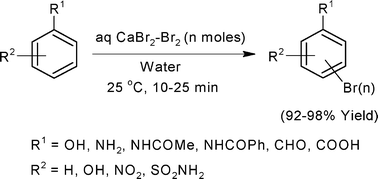An instant and facile bromination of industrially-important aromatic compounds in water using recyclable CaBr2–Br2 system
Abstract
Various industrially-important brominated intermediates have been instantly synthesized using aq.

* Corresponding authors
a
Department of Industrial Chemistry, Jiwaji University, Gwalior, Madhya Pradesh, India
E-mail:
lalitkumar0108@gmail.com
Tel: +91-9993267029
Various industrially-important brominated intermediates have been instantly synthesized using aq.

 Please wait while we load your content...
Something went wrong. Try again?
Please wait while we load your content...
Something went wrong. Try again?
L. Kumar, T. Mahajan and D. D. Agarwal, Green Chem., 2011, 13, 2187 DOI: 10.1039/C1GC15359E
To request permission to reproduce material from this article, please go to the Copyright Clearance Center request page.
If you are an author contributing to an RSC publication, you do not need to request permission provided correct acknowledgement is given.
If you are the author of this article, you do not need to request permission to reproduce figures and diagrams provided correct acknowledgement is given. If you want to reproduce the whole article in a third-party publication (excluding your thesis/dissertation for which permission is not required) please go to the Copyright Clearance Center request page.
Read more about how to correctly acknowledge RSC content.
 Fetching data from CrossRef.
Fetching data from CrossRef.
This may take some time to load.
Loading related content
